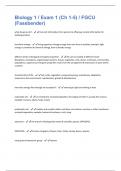Biology 1 / Exam 1 (Ch 1-5) / FGCU
(Fassbender)
what do genes do? - transmit information from parents to offspring; encode information for
building proteins
transform energy - living organisms change energy from one form to another, example: light
energy is converted to chemical energy, then to kinetic energy
different levels of biology & emergent properties - life can be studied at different levels
(biosphere, ecosystems, organs/organ systems, tissues, organelles, cells, atoms, molecules, communities,
populations, organisms); emergent properties result from the arrangement & interaction of parts within
a system
characteristics of life - cell, order, regulation, energy processing, evolutionary adaptation,
response to the environment, reproduction, growth & development
how does energy flow through an ecosystem? - entering as light and exiting as heat
eukaryotic cell - has membrane-enclosed organelles, the largest of which is usually the nucleus;
example: humans, plants, fungi, insects
prokaryotic cell - simpler and usually smaller, and does not contain a nucleus or other membrane-
enclosed organelles; example: bacteria & archaea; e coli, strep
taxonomy - the branch of biology that names & classifies species; DKPCOFGS
DKPCOFGS - Domain, Kingdom, Phylum, Class, Order, Family, Genus, Species
most general taxonomic group - domain
,least general taxonomic group - species
cell - the lowest level of organization that can perform all activities required for life
all cells... - are enclosed by a membrane and use DNA as their genetic information
systems biology - constructs models for the dynamic behavior of whole biological systems
biology - scientific study of life
fundamental characteristic of living organisms - their use of energy to carry out life's activities
work - including moving, growing, & reproducing, requires a source of energy
cell division - the basis of all reproduction, growth, & repair of multicellular organisms
DNA (deoxyribonucleic acid) - a cell's genetic material; the substance of genes
what does DNA do? - controls the development & maintenance of organisms; is inherited by
offspring from their parents
homeostasis - feedback mechanisms that allow biological processes to self-regulate
negative feedback - as more of a product accumulates, the process that creates it slows & less of
the product is produced
positive feedback - as more of a product accumulates, the process that creates it speeds up &
more of the product is produced
evolution - the process of change that has transformed life on Earth
, 3 domains of life - Bacteria, Archaea, Eukarya
Darwin's theory of "decent with modification" - organisms are modified descendants of common
ancestors
Darwin's theory of natural selection - the individuals that tend to survive & reproduce are those
that have variations best suited to the environment
science - derived from Latin & means "to know"
inquiry - the search for information and explanation
Scientific Method/Process - making observations, forming logical hypotheses, & testing
hypotheses through experimentation
observations - lead to questions & proposed hypothetical explanations
hypotheses - proposed hypothetical explanations
data - recorded observations or items of information
qualitative data - descriptions rather than measurements; red
quantitative data - measurements; 23 ounces
hypothesis - a tentative answer to a well-framed question
hypothesis must be - testable and falsifiable




